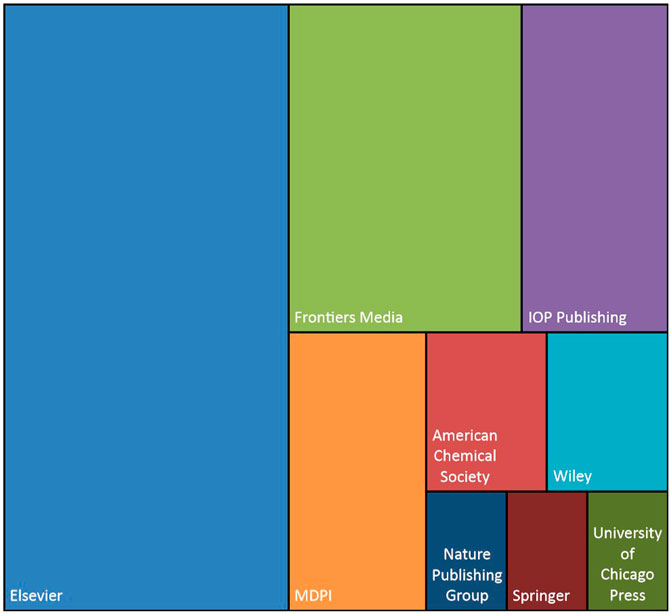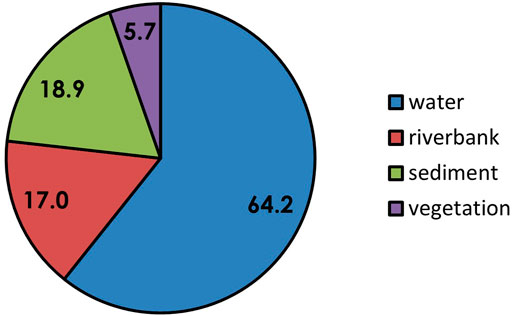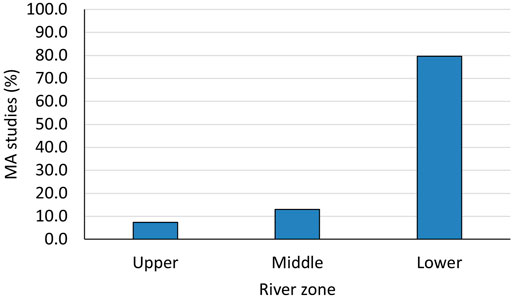Riverine macroplastic gradient along watercourses: A global overview
- Department of Sciences, University of Roma Tre, Rome, Italy
Nowadays, plastics represent growing concern in aquatic habitats, harming more and more both ecosystem and human health. Since rivers are the main carriers of plastics to the sea, some studies were conducted on the transport of overall small plastics, but observations on big plastics (i.e., macroplastics) in rivers are poorly reported in the literature. Although most studies focused on plastic transport in the lower part of the rivers, research on the upper and middle zones are completely lacking. In this regard, this could influence the transport of plastics to the sea, with insights into the source and origin of macroplastics. Here, we aimed at overviewing macroplastic distribution along rivers, emphasizing on the global riverine plastic hotspot areas. First, 1) we analyzed and discussed the bibliometric analysis on macroplastics in rivers providing a framework for plastic pollution management. second, 2) we provided geographical insights into macroplastics by mapping global riverine plastic hotspot areas. Then, 3) we analyzed the main factors affecting macroplastic distribution and accumulation in rivers. Furthermore, 4) we assessed crucial gaps in riverine macroplastic accumulation, highlighting the importance of a plastic gradient in the horizontal transport along the entire river course (i.e., three river zones). Then, 5) we highlighted the lack of standardization regarding macroplastic size, concentration, and polymers that does not allow valuable comparisons among studies. At the end, 6) we concluded by providing future perspectives and conclusions on macroplastic distribution and accumulation in rivers worldwide. Our results might provide new insights into a comprehensive framework of macroplastic distribution along global rivers, suggesting the river rod approach as a way for future monitoring as all the complete course of a river plays a pivotal role in accumulating macroplastics.
1 Introduction
Nowadays, it is well-known that plastics represent a growing concern in aquatic ecosystems. Recently, literature research has focused on assessing the effects of plastics on biodiversity and ecosystem health (van Emmerik and Schwarz 2020; Blettler and Mitchell 2021). In particular, depending on their size, plastics may have different effects (Bucci et al., 2020). To date, 76% of studies emphasize on smaller particles (microplastics, MP) with observational field studies as well as laboratory experiments (Blettler et al., 2018). In this regard, studies have highlighted that smaller plastics (MP) may harm biota and human health, causing chronic inflammation, cytotoxicity, developmental problems, toxicological threats, oxidative stress, and immune, endocrinal, and neurodegenerative diseases (Campanale et al., 2020; Naqash et al., 2020; Prata et al., 2020; Kukkola et al., 2021; Pironti et al., 2021; Buwono et al., 2022; Han et al., 2022). However, given these issues, the most important thing is to understand the origin of MP. In detail, MP can originate industrially as primary MP (see cosmetics such as scrubs, see Eerkes-Medrano et al., 2015) or mainly originate by degradation of big plastics (macroplastics, MA). In particular, although MA are understudied, they are the main source of secondary microplastics, which originates from macroplastic degradation (see Gallitelli et al., 2021a). Hence, for this reason, the release of MA into the environment is a widespread issue that should not be underestimated. However, although rivers are the main carrier of plastics to the sea (Lebreton et al., 2017; Gallitelli et al., 2020; Meijer et al., 2021), few studies were conducted on MA in rivers (van Emmerik 2021). As known from the literature, research focuses mainly on MP rather than MA (Bucci et al., 2020). In particular, the distribution and transport of MA in rivers, mainly due to several factors, is poorly understood and investigated (van Emmerik et al., 2019; Liro et al., 2020). Given these gaps, in this study we aimed at investigating further the transport, distribution, and accumulation of MA in rivers.
Regarding MA in rivers, some research biases and knowledge gaps on underestimated threats (i.e., interaction among MA and freshwater biota) in freshwater plastic pollution have been identified by Blettler et al. (2018) and Blettler and Wantzen (2019). Although many studies reviewed about macroplastics in freshwaters, specific review on MA in rivers is still scarce (Bucci et al., 2020; Winton et al., 2020). In detail, while Winton et al. (2020) assessed macroplastics in freshwaters, Bucci et al. (2020) focused on the effect of plastic on biota in marine, freshwater, and terrestrial ecosystems, considering both laboratory and field studies. Then, van Emmerik and Schwarz (2020) discussed the current state of riverine plastic debris, also giving a background on the origin and fate of plastics and factors affecting transport and spatiotemporal variation of plastic debris along rivers. Finally, Al-Zawaidah et al. (2021) reviewed the occurrence of MA in freshwaters, describing the various factors affecting macroplastic dynamics along rivers. However, as the literature has been focused on MP for years, only few research studies have reviewed riverine macroplastics in rivers (Bucci et al., 2020; van Emmerik and Schwarz, 2020; Winton et al., 2020; Al-Zawaidah et al., 2021). Thus, gap of knowledge still exists on the source and origin of riverine macroplastic litter(Blettler and Wantzen 2019). However, it is pivotal to understand where plastics end, as not all the plastics flow to the sea. Indeed, although majority of studies indicated the lower part of rivers as the main carrier of plastics to the sea (see González-Fernández et al., 2021; Meijer et al., 2021), no studies analyzed MA along the entire river rod. As unraveling the source and origin of MA is a key factor for plastic management and removal, we aimed at further investigating riverine plastic distribution in global rivers. We analyzed the bibliometric analysis on MA in rivers, thus providing a framework for plastic pollution management. In particular, we discussed the MA riverine transport along the world, putting our emphasis on the riverine plastic hotspot areas in worldwide geographical areas. Then, we assessed crucial gaps in riverine MA accumulation, highlighting the importance of a plastic gradient in the MA horizontal transport along the entire river rod.
2 Materials and methods
2.1 Metadata search
To collect data on the number of studies on plastics, a bibliographic search has been conducted on both the Web of Science (hereafter, WS) and Scopus (hereafter, SC), the two most used web engines as the most comprehensive data sources for various purposes (e.g., see Harzing and Alakangas 2016; Li et al., 2018; Zhu and Liu 2020). Thus, to explore the number of studies focusing on plastics within different habitats (e.g., marine, freshwater, terrestrial, atmospheric), we searched for “macroplastic” or “mesoplastic” or “microplastic” and “marine” or “freshwater” or “terrestrial” or “atmospheric” from 2013 to the 31st of December 2021. For this first exploratory analysis, as WS and SC provided similar results, we used the mean value of the summed results obtained from WS and SC. Furthermore, to achieve our main aim of MA in rivers, we searched for “macroplastic” and “river” on WS and on SC from 2013 to 31 December 2021, as the year 2013 has been chosen as the first year for the first study of macroplastics in rivers.
We also checked for “mesoplastic” and “river” on WS and SC as mesoplastics are considered items greater than 5 mm (sensu Lippiatt et al., 2013). Given that only a few studies used the term “mesoplastics” (i.e., Lippiatt et al., 2013, 5 mm < plastics<2.5 cm) and other authors considered this range as macroplastics (i.e., all the items greater than 5 mm), we decided to include the range and the term ME into macroplastics.
After searching, we selected articles according to our quality criteria (e.g., MA flux and transport, river zone, plastic polymer, and typology). Preferred reporting items for systematic reviews and meta-analyses (PRISMA) guidelines were used to represent the article selection process through graphical method (Supplementary Figure S1, see Moher et al., 2009).
For each study, we extrapolated quantitative and qualitative information on 1) MA in ecosystems with a focus on rivers, 2) MA size and concentration threshold, and most abundant polymers found, 3) geographical area (e.g., continent and country), and 4) MA gradient in river zones (i.e., three river zones: upper, middle, and lower course).
We set criteria for data information on 1) three river zones following Vannote et al. (1980), and 2) local land-use, by using study area map provided into articles and additionally Google Earth imageries. For the three river zones, the upper part was considered the one in which the river was flowing in a mountain context, the middle in the hill landscape, and the lower part is represented by the planitial floodplain part also considering the river mouth (Vannote et al., 1980). Thus, we divided rivers into three parts, also taking into account the length (i.e., km) of the rivers (i.e., dividing into three equally long sections).
Regarding polymers, PE, PP, PS, PVC, and PET are the most found polymers for MP in freshwater (Koelmans et al., 2019; Schwarz et al., 2019). However, in the literature there is not a standard classification for macroplastic polymers. In particular, many authors considered HDPE and LDPE as PO soft (see Vriend et al., 2020), while others considered HDPE and PP as PO hard, and LDPE as PO soft (van Emmerik et al., 2018). In general, PE and PP are considered PO (van Emmerik et al., 2020b). Thus we decided to unify PO soft and PO hard into a general class of PO, with PP as an external class. Also, note that PVC is not mentioned in all these classifications. For all these reasons, considering 1) the most occurring MA polymers and 2) the used classification for sampling MA, we classified plastic items into these classes: PO, PP, PET, E-PS, PS, PVC, multilayer, other.
In our bibliometric analysis (e.g., most investigated continent), we considered a study twice if it is reporting different values as it is studying different rivers, and so the same article showed two different MA concentrations for the two sampled rivers. For other type of analysis, we considered the article as one. For instance, when comparing the plastic size and the methods, we reported the threshold for all the results. For most countries investigating MA in rivers, we considered both the countries if an author possessed double affiliation.
Considering the metadata, results will be shown following: 1) an overview of MA in several ecosystems with a focus on riverine MA. 2) We highlighted, in detail, the geographical areas with insights on plastic hotspot areas. 3) We discussed the main factors that affect MA distribution and accumulation along rivers. 4) We highlighted a plastic gradient along watercourses. 5) Furthermore, we emphasized the lack of standardization regarding MA size, concentration, and polymers. 6) At the end, we concluded by providing future perspectives and conclusions on MA distribution and accumulation in rivers worldwide.
2.2 Statistical analyses
Before the analysis, data were checked for normality using the Shapiro-Wilk test. Also, data transformation (e.g., integer numbers) was conducted when the distribution was not normal, and eventually non-parametric tests were performed.
To further investigate a possible association between the year of publication and the number of studies, we performed a Spearman’s rank correlation test.
To assess if the scientific article production per country depends on the development of a country, we performed a Pearson correlation test and a regression analysis. For this purpose, the development of a country is measured by the Human Development Index (HDI), provided by https://worldpopulationreview.com/country-rankings/developed-countries.
To highlight a possible relation between produced plastics (Plastics Europe 2021) and metadata plastics, we performed a χ2 test. To do so, we transformed data from percentages to integer numbers.
All statistical analyses were performed using GraphPad Prism 8.4.2.
3 Results
3.1 Bibliometric analysis on MA and MP in rivers
Overall, a total of 159 references were found after searching on WS and SC (Supplementary Table S1). Then, we eliminated 88 articles, with 54 articles which focused on marine plastic pollution or were systematic reviews without reporting data (Supplementary Figure S1). At the end, we considered 42 articles which met our specific quality criteria (e.g., MA flux and transport, river zone, plastic polymer, and typology, see Supplementary Table S2).
At the moment, macroplastics has risen as a topic getting more attention in all environments (mean number of results obtained by WS and SC: MA, n = 199.5; MP, n = 4,046.5, Figure 1). Overall, 95% of the studies focused on MP, while only 5% on MA. According to WS and SC, MA and MP are more studied in marine ecosystems (75.9 and 67.2%, respectively), followed by freshwaters (12.3 and 18.3%), terrestrials (10.0 and 9.8%), and atmospherics (1.8 and 4.7%) (Figure 1).
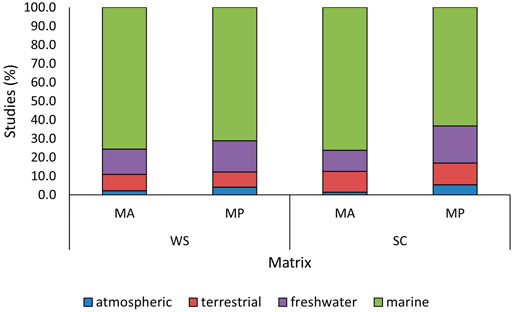
FIGURE 1. (a) Occurrence of macroplastics (MA) and microplastics (MP) in marine, freshwater, terrestrial, and atmospheric matrices. WS = Web of Science; SC = Scopus.
Bibliometric analysis revealed that MA in freshwaters are understudied (Figure 2). Specific to our aims, only 42 studies have been carried out on MA in rivers. However, in the last 5 years, research on MA has highly increased in rivers (Figure 3, Supplementary Fig. S2).

FIGURE 2. Number of studies (No.) for (A) freshwater and (B) marine macro-, meso- and microplastics.
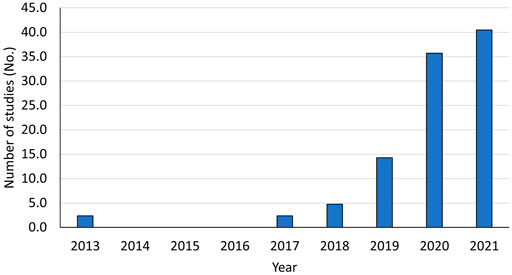
FIGURE 3. Number of studies (No.) on macroplastics is significantly increasing with years (rs = 0.85, p < 0.05).
Research on MA in riverine ecosystems started in 2013, with exponential growth from 2017 to 2021 (Figure 3). In particular, we found a significant positive association between the publication year and the number of studies (rs = 0.85, p < 0.05; Figure 3). In these 4 years (from 2017 to 2021), the number of articles on plastics has increased as shown in Figure 3, and although studies on MP skyrocketed from 76 to 95%, increasing considerably, the number of studies on MA has also risen considerably.
3.2 Macroplastic geographical insights: Global riverine plastic hotspot areas
Most of studies were published on Environmental Pollution (14.3%), Marine Pollution Bulletin and Science of the Total Environment (both 11.9% each one), and Environmental Research Letters, and Frontiers in Earth Science and Frontiers in Marine Science (all these ones accounting for 7.1% itself). About publishers, Elsevier (42.9%), Frontiers Media (19.0%), IOP Publishing (11.9%), and MDPI (9.5%) are the main ones (Figure 4). Among articles, open access, gold, green (53.7%), not open access (29.3%), hybrid (9.8%), and bronze open access (7.3%) are the most frequently occurring publishing ways. In general, the topic of MA, although understudied, is recently getting more attention as MA may cause several concerns at different biological levels, such as MP; thus, these well-published journals noticed this problem, and so they decided to publish more on this. Indeed, plastics are a significant phenomenon getting more attention, so journals face this topic in this period. In more detail, the difference between editors is not a pivotal role since we have to consider that several publishers are publishing on this topic as it is a well-recognized problem.
Regarding continents in which field samplings were carried out, most studies on riverine MA focused on Asia (42.6%) and Europe (36.2%), while just a few studies were conducted in Africa (10.6%), North America (6.4%), and South America (4.3%). No studies have been carried out in Oceania and Antarctica (Figure 5A). The top countries focusing on MA research in rivers are 1) Netherlands (34.1%), 2) France (11.4%), and 3) Germany (11.4%). Also, the countries that produced more articles are non-significantly the more developed or richer ones (rP = 0.38, p = 0.18; R2 = 0.14, p = 0.18, Y = 12.72*X—7.804,Supplementary Figure S3). In detail, this could be due to the increased awareness towards plastic, although various studies have proven that most research on plastics in freshwaters were carried out by developed countries (see Blettler et al., 2018 on developing and developed countries).

FIGURE 5. (A) Frequency of studies on macroplastics in rivers (%) conducted in each continent. (B) Global distribution of macroplastics (i.e., number of studies) in rivers carried out in each country. Note that global riverine plastic hotspot areas mainly focused on Asia and Europe. Images obtained with Excel and Bing technology.
Regarding the countries where samplings were mainly conducted, the top-10 countries (i.e., global riverine plastic hotspot areas) accounted for 86.0% of the total (e.g., Vietnam, Indonesia, Netherlands, France, Germany, South Africa, Philippines, United States, Argentina, Korea, see Figure 5B).
These results are also in line with the literature (van Calcar and van Emmerik 2019). Indeed, van Calcar and van Emmerik (2019) found that European and Asian rivers showed an abundance of plastic debris. Although MA can give origin to MP particles, it seems surprising how MA is extremely understudied. Thus, in those countries where plastic pollution has not yet been detected, citizen science might be used to tackle the problem.
In particular, although most studies were carried out in Asia and Europe, the Netherlands, a European country, conducted more studies on MA worldwide, so we should consider that the management of the plastic problem among countries is completely different. In fact, while research on MA was mainly carried out by the Netherlands, in Asia most of the studies were conducted by several countries. Indeed, we should consider that the concern of MA may be generalized, such as, for instance, macroplastic litter on riparian vegetation might not allow flowers to be emitted, affecting pollination (Gallitelli et al., 2022; Gallitelli and Scalici 2022, submitted), and this phenomenon might occur in Asia as well as in the Netherlands, however, the riverine catchment is different in both sites, and therefore the problem should be faced and managed with different dynamics. Furthermore, research should be stimulated in other countries because there is a regionalization of river management, for instance, how rivers’ flows are controlled. In fact, in northern countries there is a continental climate and different factors providing more water within rivers, while in the southern countries there is less water, mainly due to the high climate seasonality and the presence of intermittent rivers (see Tramblay et al., 2021; see Sauquet et al., 2020; 2021).
Concerning the matrix of MA monitoring, water was the most investigated (64.2% of total studies), followed by sediment, riverbank, and vegetation (18.9, 17.0, and 5.7%, respectively). While most studies on water were focused on “floating MA”, research on sediment focused on “sink MA”. Although most studies investigated surficial and floating plastics, no studies were conducted on “submerged MA” in the water column. However, “trapped MA” are the ones occurring on vegetation and riverbanks (Figure 6).
3.3 Main factor affecting MA distribution and accumulation
Along rivers, plastic may be driven from spring to the mouth, being carried to the sea (Lebreton et al., 2017; Gallitelli et al., 2020; Meijer et al., 2021). Thus, the plastic transport proceeds downstream due to the river current. However, mainly in the pool part of the river, there might be a storage zone where plastics undergo sinking. In this regard, the pool of rivers may be considered as plastic reservoirs and (long-term) sinks for plastic pollution (van Emmerik et al., 2022). With extreme events (e.g., floods and rain, also enhanced by climate change), MA items, due to a remobilization, continue their flow to the sea (Liro et al., 2020; Roebroek et al., 2021). More in particular, climate change, driven by extreme events (e.g., cyclone, monsoons, floods), might boost and enhance plastic pollution in an unexpected way, also affecting the seasonality of plastic transport and distribution. In fact, although a strong seasonality for plastics has been investigated in literature, highlighting both daily and monthly variations (e.g., Crosti et al., 2018; Castro-Jiménez et al., 2019; van Emmerik et al., 2019), climate change and extreme events might affect the phenomenon of seasonality, leading to unexpected plastic events, that may bring exaggerated amount of plastics. Moreover, rainfall, river discharge, and the presence of organic material strictly influenced the flow of MA along watercourses (van Emmerik et al., 2019; van Emmerik et al., 2022). Therefore, MA riverine transport is crucial for understanding MA distribution along rivers and spotting their accumulation areas (see the “river plastic gradient” in Figure 8).
Further, information on the abiotic factors driving MA transport and dynamics along rivers (e.g., MA chemical and physical proprieties and hydrogeomorphological interactions) has been preliminarily pointed out (see van Emmerik et al., 2019; Liro et al., 2020; Al-Zawaidah et al., 2021). However, although abiotic factors might have a central role for the downstream MA transport, biotic factors are also fundamental for understanding MA distribution (see Figure 6). Indeed, as mangroves and psammophilous plants block macroplastic litter in transitional and coastal habitats (Martin et al., 2019; Gallitelli et al., 2021b), aquatic and riparian vegetation may play a role in riverine macroplastic transport (Liro et al., 2020; Schreyers et al., 2021; Cesarini and Scalici 2022; Gallitelli et al., 2022).
3.4 Meta-analysis on MA distribution and plastic gradient
Regarding metadata analysis on the distribution of MA in river zones, overall, 79.6% of research assessed MA pollution in lower potamal zone of watercourses (Figure 7). Thus, research focuses mainly on the ends of rivers, while no studies have been performed on the entire river rod. In particular, the only study conducted for the upper part was in North America (United States), while the middle course studies were carried out in France, South Africa, and Indonesia.
In this regard, most research focused on the river potamal part and so, for this reason, the main plastic information is found in this part of the watercourse. In particularly, this plastic accumulation pattern could be explained by the River Continuum Concept (Vannote et al., 1980), wherein in the potamal zone of rivers, organic detritus is carried from the upstream parts. However, we also observed MA in the upstream parts of some rivers in Central Italy (e.g., Farfa, Tronto, Velino, Licenza, Mignone, Marta, Aniene, and Tiber Rivers, Gallitelli et al., 2022). As MA are found upstream in rivers, we pointed out that it may act as a source of plastic pollution. Thus, this global pattern of plastic distribution should also be predicted with our observational findings. Indeed, as river zones change according to abiotic and biotic factors (Vannote et al., 1980), we also expect that macroplastic litter distribution may vary due to the different characteristics of each river zone. Indeed, we should consider that the river is getting larger going from the upper to the lower potamal zone. For all these reasons, we observed 1) plastic accumulation mainly in the potamal lower course of rivers, and then 2) a plastic gradient showing a difference regarding the size and typology of plastic items among three river zones, as plastic type and size change along the rivers (Gallitelli et al., 2022, Figure 8).
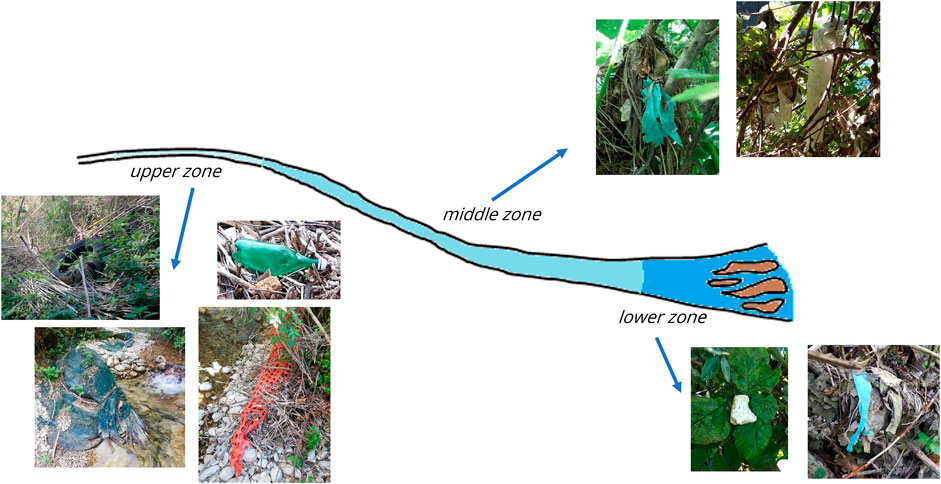
FIGURE 8. Macroplastic field observations (Gallitelli et al., 2022) along watercourses in Latium (Central Italy).
Compared with literature, our MA trend along the river zones follows that stated by Gallitelli et al. (2020) for MP in rivers. In that case, MP concentration in water increased from spring to the mouth of river Mignone in central Italy (Gallitelli et al., 2020). Finally, our findings can provide information on the source of plastic pollution. In fact, in this case, we observed that great size (i.e., macro) and mismanaged plastic waste dominated the highest parts of rivers.
Furthermore, this plastic gradient trend could be affected by local factors, such as discharge and run-off, high population density, metropolis, but also local land use. From the metadata, we pointed out that urban (metropolitan) is the most frequently occurring (64.3%), followed by agricultural crops (12.5%), while industrial land use is the least present (5.4%) (Figure 9).
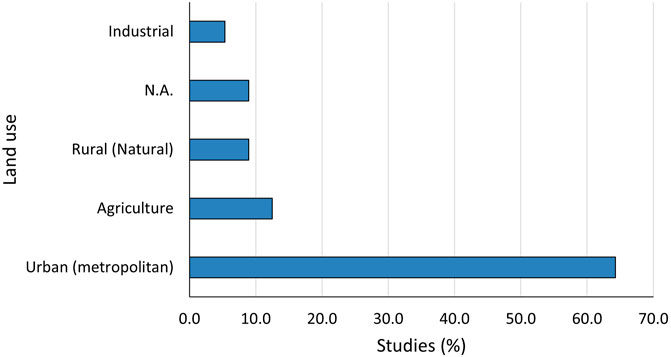
FIGURE 9. Land use metadata occurring in studies (%) on macroplastics in rivers. N.A. (not assessed) indicated that the data were not reported for the specific study.
Although it is well known that river mouth acts a sink for MA (van Emmerik et al., 2020a), rivers may also retain plastics (Gallitelli et al., 2022; van Emmerik et al., 2022), thus we should also take into account that the complete course of a river (i.e., three river zones) plays a pivotal role in accumulating MA (such as in meander, sediment, riverbank, and also on riparian vegetation). Thus, as the total emission of a river is not the only one leaked by its mouth, we suggest evaluating MA distribution and accumulation not only at the river mouth, but also along the entire river rod with a large-scale approach.
3.5 Macroplastic size and concentration: A problem of standardization
Regarding the size and concentration of MA in rivers, there is a problem of standardization for both topics (Figures 10,11, Table 1). Although plastic pollution is a well-felt and very popular problem, as highlighted by the increasing number of articles in recent years, despite reporting the problem, there is a lack of uniformity as concerns results based on 1) size and 2) concentration (i.e., quantification) of plastics in the aquatic environment. This leads to a lack of standardization with a consequent “comfortably numb” in taking political decisions to tackle the problem.
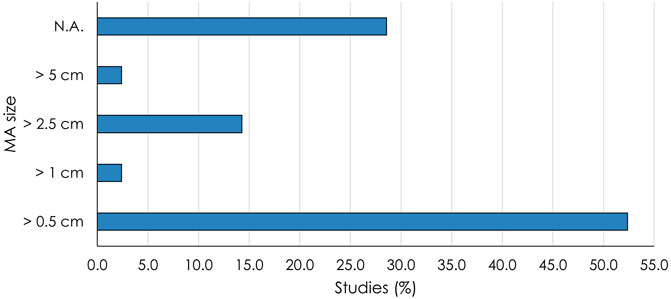
FIGURE 10. Threshold for macroplastic (MA) size adopted in different studies (%). N.A. represents the studies in which the threshold size was not assessed.
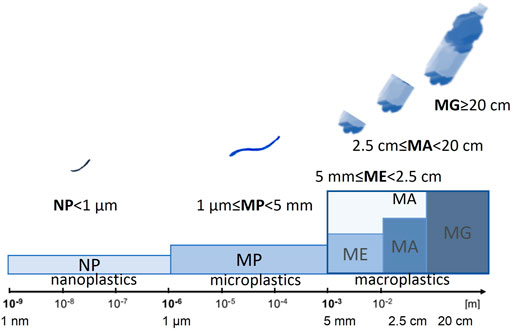
FIGURE 11. New nomenclature proposal of plastic classification (by Hartmann et al., 2019, modified). NP = nanoplastics; MP = microplastics; ME = mesoplastics; MA = macroplastics; MG = megaplastics. Note that ME, MA, and MG reported in the literature are all grouped within MA in this review.

TABLE 1. Ways to express macroplastics’ quantity (MA quantity) observed in the field, reported in the literature. The second column indicates the number of articles (No.), also reported in percentage (%) in the last column.
Concerning plastic size (Figure 10), most authors followed the threshold of 0.5 cm, considering all other than microplastics are macroplastics (MP < 0.5 cm, see Arthur et al., 2018; Barnes et al., 2009; Thompson et al., 2009; Gasperi et al., 2014; Faure et al., 2015; Lahens et al., 2018; Lebreton et al., 2019; Gallitelli et al., 2020; Liro et al., 2020; van Emmerik et al., 2020b; Winton et al., 2020; Nihei et al., 2020; Bucci et al., 2020; Al-Zawaidah et al., 2021; Roebroek et al., 2021; Earn et al., 2021; van Emmerik 2021). In addition, few authors used the >2.5 cm standard, also indicated by European large project on riverine MA monitoring, such as the RIMMEL project (see Lippiatt et al., 2013; Cheshire 2009; EC JRC (2016a); GESAMP 2016; Wagner et al., 2014; Blettler et al., 2017; Blettler et al., 2018; González-Fernández et al., 2021; Moss et al., 2021). Moreover, some literature call mesoplastics (0.5 cm < ME < 2.5 cm, sensu Lippiatt et al., 2013) which instead is considered macroplastics by other authors (MA > 0.5 cm, sensu Arthur et al., 2018; Barnes et al., 2009; Thompson et al., 2009; Liro et al., 2020; van Emmerik 2021). For this reason, these results do not allow a common and international standardization, and thus do not provide valuable comparison among studies, useful for plastic monitoring. This could be a concern, mainly in terms of tackling this threat (e.g., in removal actions and clean-ups).
Thus, to avoid this lack of uniformity, we would like to standardize by proposing the most appropriate plastic size classification considering the main classification studies used in literature (see Figure 11, also following Hartmann et al., 2019): nanoplastics (<1 µm), microplastics (1 µm ≤ MP < 5 mm), macroplastics (MA≥5 mm). In this regard, we agree with literature that NP <1 µm and MP are plastics ranging between 1 μm and 5 mm (as reported by Lippiatt et al., 2013; European Commission (2013); van Emmerik et al., 2018; Blettler et al., 2018; van Emmerik 2021). Although most studies in the literature considered macroplastic as bigger than 0.5 cm and considering that mesoplastics cover a range overlapped with the range of macroplastics for many authors (i.e., 0.5–2.5 cm), we suggest using the term “macroplastics” for big plastics referring to ME, MA, and MG (Figure 11). Thus, the terms ME and MG would be replaced as they were completely understudied and not often used. In detail, literature reported mainly MA as greater than 0.5 cm (sensu Arthur et al., 2018; Barnes et al., 2009; Thompson et al., 2009; Eriksen et al., 2014; van Emmerik et al., 2020a; Liro et al., 2020) (see Figure 10). We should also consider that macroplastic litter was classified into several sizes (i.e., 2.5–5 cm, 5–10 cm, 10–20 cm, 20–30 cm, 30–50 cm, >50 cm) when monitoring floating MA (González-Fernández and Hanke 2017). Finally, this standardization has an important practical role as MA size obtained by metadata has been used for sampling plastics in this study (e.g., riparian habitats, floating macrolitter monitoring, etc.). We should recommend using this size classification following this guideline.
Regarding the concentration of MA, this quantification has been reported mainly as: 1) number of items occurring in situ, 2) length related measure (e.g., number of items found per area, volume, or kilometers), 3) time-related measure (e.g., number of items per minutes, hours, year) 4) mix of weight (e.g., ton or grams), and time (e.g., year, day), so for instance ton/year, kg/day, or g inhabitant−1 day−1. Although all these measures are dependent on several different aims, the results are however different, not allowing standard uniformities among studies—that are required for tackling plastic pollution through policy making actions and removal action plans. Among these, MA concentration is mainly reported as number of items (25.0%) followed by items/m2 (11.2%), and items/h (10.0%). Thus, considering macro-category, MA items can be standardized as 1) number of items (25.0%), 2) time-related result (25.0%), 3) space-related (16.3%), 4) weight-related result (3.8%), or 5) a mix among space, time, and weight (21.3%) (Table 1).
To date, MA concentration has been recorded in rivers (e.g,. number of items, items/m2, emission as ton of items per year, see Winton et al., 2020; Al-Zawaidah et al., 2021) as well as the threshold size for MA items (e.g., >2.5 cm, >0.5 cm, >2 cm, >5 cm). Also, the dominant polymer and the transport mechanism (e.g., water, riverbanks, floating and suspended, riverbed) have been reported, without quantifying them.
To quantify the flux of plastic flowing from land to the sea through rivers, few studies modelled the MA concentration globally distributed along rivers (Lebreton et al., 2017; Meijer et al., 2021). However, although we observed from metadata that there is a complex dis-uniformity and non-standardization concerning the unit of MA concentration, we should consider that these different studies are focusing on several aspects of MA distribution along rivers. Therefore, some authors focused on MA flux and transport, others on MA concentration, and thus, we concluded that it is still complicated to uniform a standard concentration comparison. Global guidelines should be defined to 1) make results comparable each other and, consequently, to 2) achieve future removal implication for mitigating the plastic pollution problem.
Concerning the polymers, while some authors reported the typology of MA items (e.g., wrap, packaging, etc.), others reported the relative polymer (e.g., PS, PET, etc.). Also, for polymers, there is a lack of standardization. Among polymers (Figure 12A), the most abundant polymer from metadata resulted to be PO (26.0%), followed by other (16.5%), PET (16.1%), E-PS/PS (12.2 and 9.6%, respectively), multilayer (9.1%), PP (7.3%), and PVC (3.1%). Related to countries (Supplementary Figure S4), PO and E-PS are more abundant in Indonesia, the Netherlands, and Vietnam, while PET is abundant in Vietnam, United States, and South Africa (Figure 12B). In general, the main polymers produced in the world are PO (33.4%), other (30.6%), and PP (26.4%) (Plastics Europe 2021). Moreover, we found a significant difference between produced plastics (Plastics Europe 2021) and metadata plastics (χ2 = 206.1, df = 5, p < 0.05). Although PE (within PO) and PP are indicated to contribute most to MP pollution in all environments (Koelmans et al., 2019; Schwarz et al., 2019), research indicating the most occurring MA polymers in global rivers has not been conducted.
4 Future perspectives and knowledge gaps
In a microplastic era (van Emmerik 2021), microplastic pollution should be considered a continuum of macroplastics, and thus studies might focus on MA as a proxy for MP. Concerning macroplastic studies, only a few studies were carried out in freshwater ecosystems. Particularly, Bucci et al. (2020) and Al-Zawaidah et al. (2021) reviewed about MA occurrence in freshwaters. Also, Blettler et al. (2018) reviewed the knowledge gaps and underestimated topics, (i.e., interaction among MA and freshwater biota). In riparian habitats, we observed plastic accumulation areas where MA can cause detrimental effects on freshwater biota and riparian habitats. Here, we would summarize several knowledge gaps that we recommend being filled to implement plastic pollution research. First, MA may interact with riparian vegetation and ecosystem services. In this regard, we observed that MA on riparian vegetation does not allow flowers to be emitted by plants, causing a local loss of the pollination service (Gallitelli et al., 2022). Second, MA in riparian habitats can be used as nesting material and might entangle animals. Although primary observations have been performed in this regard by Blettler and Mitchell (2021), this is one of the most underestimated topics for freshwater plastic pollution. Third, future studies should put their emphasis on tackling plastic pollution using all the published literature. Also, using citizen science and providing awareness of the problem to people, could be of great importance for achieving it (Kiessling et al., 2021). In detail, future research would be encouraged to focus on 1) standardizing the different plastic size thresholds used in literature, 2) monitoring plastic pollution on the entire river course (i.e., sampling along three river zones), and 3) assessing whether MA distribution and transport along rivers might be affected by other factors (e.g., river width, riparian vegetation, natural barrages). For understanding plastic distribution, cutting-edge technologies (i.e., satellites and drones) may be used for detecting floating MA using an experimental remote sensing approach (Tasseron et al., 2021). Also, monitoring and detecting “submerged” plastics in rivers using an echo-sounding approach (Broere et al., 2021).
Literature search shows that vegetation has not been much studied and that these studies are going to be approached now as literature has few studies, and more data must be collected globally. This is not because there is a lack of interest but because, so far, the focus has been on MP. The focus is now shifting to MA because, in addition to causing damage per se to plants (e.g., pollination service, see Gallitelli and Scalici 2022, submitted), MA are potential sources of micro- and nano-plastics causing problems of different order. From preliminary observations (e.g., our studies and literature research), vegetation seems to be damaged by plastics, but it can be useful for trapping plastic by taking it away from the water (e.g., ecosystem service of plastic entrapment, see Cesarini and Scalici 2022; Gallitelli et al., 2022).
Author contributions
LG: conceptualization, formal analysis, data curation, investigation, writing—original draft, and writing—review and editing. MS: conceptualization, supervision, funding acquisition, and writing—review and editing. All authors contributed to the article and approved the submitted version.
Funding
This research was supported by the Grant of Excellence Departments, MIUR-Italy (ARTICOLO 1, COMMI 314–337 LEGGE 232/2016).
Acknowledgments
The authors would like to thank the reviewers for improving our manuscript with their valuable suggestions.
Conflict of interest
The authors declare that the research was conducted in the absence of any commercial or financial relationships that could be construed as a potential conflict of interest.
Publisher’s note
All claims expressed in this article are solely those of the authors and do not necessarily represent those of their affiliated organizations, or those of the publisher, the editors, and the reviewers. Any product that may be evaluated in this article, or claim that may be made by its manufacturer, is not guaranteed or endorsed by the publisher.
Supplementary material
The Supplementary Material for this article can be found online at: https://www.frontiersin.org/articles/10.3389/fenvs.2022.937944/full#supplementary-material
References
Al-Zawaidah, H., Ravazzolo, D., and Friedrich, H. (2021). Macroplastics in rivers: Present knowledge, issues and challenges. Environ. Sci. Process. Impacts 23, 535–552. doi:10.1039/D0EM00517G
Arthur, C., Bamford, H., and Baker, J. (2018) The Occurrence, Effects and Fate of Small Plastic Debris in the Oceans, 17.
Barnes, D. K. A., Galgani, F., Thompson, R. C., and Barlaz, M. (2009). Accumulation and fragmentation of plastic debris in global environments. Phil. Trans. R. Soc. B 364, 1985–1998. doi:10.1098/rstb.2008.0205
Blettler, M. C. M., Abrial, E., Khan, F. R., Sivri, N., and Espinola, L. A. (2018). Freshwater plastic pollution: Recognizing research biases and identifying knowledge gaps. Water Res. 143, 416–424. doi:10.1016/j.watres.2018.06.015
Blettler, M. C., and Mitchell, C. (2021). Dangerous traps: Macroplastic encounters affecting freshwater and terrestrial wildlife. Sci. Total Environ. 798, 149317. doi:10.1016/j.scitotenv.2021.149317
Blettler, M. C. M., Ulla, M. A., Rabuffetti, A. P., and Garello, N. (2017). Plastic pollution in freshwater ecosystems: Macro-meso-and microplastic debris in a floodplain lake. Environ. Monit. Assess. 189, 581. doi:10.1007/s10661-017-6305-8
Blettler, M. C. M., and Wantzen, K. M. (2019). Threats underestimated in freshwater plastic pollution: Mini-review. Water Air Soil Pollut. 230, 174. doi:10.1007/s11270-019-4220-z
Broere, S., van Emmerik, T., González-Fernández, D., Luxemburg, W., de Schipper, M., Cózar, A., et al. (2021). Towards underwater macroplastic monitoring using echo sounding. Front. Earth Sci. 9, 628704. doi:10.3389/feart.2021.628704
Bucci, K., Tulio, M., and Rochman, C. M. (2020). What is known and unknown about the effects of plastic pollution: A meta‐analysis and systematic review. Ecol. Appl. 30, e02044. doi:10.1002/eap.2044
Buwono, N. R., Risjani, Y., and Soegianto, A. (2022). Oxidative stress responses of microplastic-contaminated Gambusia affinis obtained from the brantas river in east java, Indonesia. Chemosphere 293, 133543. doi:10.1016/j.chemosphere.2022.133543
Campanale, C., Massarelli, C., Savino, I., Locaputo, V., and Uricchio, V. F. (2020). A detailed review study on potential effects of microplastics and additives of concern on human health. Int. J. Environ. Res. Public Health 17 (4), 1212. doi:10.3390/ijerph17041212
Castro-Jiménez, J., González-Fernández, D., Fornier, M., Schmidt, N., and Sempéré, R. (2019). Macro-litter in surface waters from the rhone river: Plastic pollution and loading to the NW mediterranean sea. Mar. Pollut. Bull. 146, 60–66. doi:10.1016/j.marpolbul.2019.05.067
Cesarini, G., and Scalici, M. (2022). Riparian vegetation as a trap for plastic litter. Environ. Pollut. 292, 118410. doi:10.1016/j.envpol.2021.118410
Cheshire, A., Adler, E., and Barbière, J. (2009). UNEP/IOC guidelines on survey and monitoring of marine litter. Nairobi : Paris: United Nations Environment Programme, Regional Seas Programme ; Intergovernmental Oceanographic Commission, Integrated Coastal Area Management and Regional Programme.
Crosti, R., Arcangeli, A., Campana, I., Paraboschi, M., and González-Fernández, D. (2018). ‘Down to the River’: Amount, composition, and economic sector of litter entering the marine compartment, through the Tiber River in the western mediterranean sea. Rend. Fis. Acc. Lincei. 29, 859–866. doi:10.1007/s12210-018-0747-y
Earn, A., Bucci, K., and Rochman, C. M. (2021). A systematic review of the literature on plastic pollution in the Laurentian Great Lakes and its effects on freshwater biota. J. Gt. Lakes. Res. 47, 120–133. doi:10.1016/j.jglr.2020.11.001
EC JRC (2016a). European commission, joint research center. Exploratory research project: RIMMEL (RIverine and marine floating macro litter monitoring and modeling of environmental loading). Available online at: http://mcc.jrc.ec.europa.eu/dev.py?N=simple&O=380&titre_page=RIMMEL&titre_chap=JRC%20Projects.
Eerkes-Medrano, D., Thompson, R. C., and Aldridge, D. C. (2015). Microplastics in freshwater systems: A review of the emerging threats, identification of knowledge gaps and prioritisation of research needs. Water Res. 75, 63–82. doi:10.1016/j.watres.2015.02.012
Eriksen, M., Lebreton, L. C. M., Carson, H. S., Thiel, M., Moore, C. J., Borerro, J. C., et al. (2014). Plastic pollution in the world’s oceans: More than 5 trillion plastic pieces weighing over 250, 000 tons afloat at sea. PLoS ONE 9, e111913. doi:10.1371/journal.pone.0111913
European Commission (2013). Joint research centre. Guidance on monitoring of marine litter in European seas. LU: Publications Office Available at: https://data.europa.eu/doi/10.2788/99475 (Accessed February 22, 2022).Institute for environment and sustainability. And MSFD technical subgroup on marine litter.
Faure, F., Demars, C., Wieser, O., Kunz, M., and de Alencastro, L. F. (2015). Plastic pollution in Swiss surface waters: Nature and concentrations, interaction with pollutants. Environ. Chem. 12, 582. doi:10.1071/EN14218
Gallitelli, L., Battisti, C., Olivieri, Z., Marandola, C., Acosta, A. T. R., Scalici, M., et al. (2021b). Carpobrotus spp. patches as trap for litter: Evidence from a mediterranean beach. Mar. Pollut. Bull. 173, 113029. doi:10.1016/j.marpolbul.2021.113029
Gallitelli, L., Cera, A., Cesarini, G., Pietrelli, L., and Scalici, M. (2021a). Preliminary indoor evidences of microplastic effects on freshwater benthic macroinvertebrates. Sci. Rep. 11 (1), 720. doi:10.1038/s41598-020-80606-5
Gallitelli, L., Cesarini, G., Cera, A., Sighicelli, M., Lecce, F., Menegoni, P., et al. (2020). Transport and deposition of microplastics and mesoplastics along the river course: A case study of a small river in central Italy. Hydrology 7, 90. doi:10.3390/hydrology7040090
Gallitelli, L., Cutini, M., and Scalici, M. (2022). The net trapping effect”: Is riparian vegetation affecting riverine macrolitter distribution? Vienna, Austria: EGU General Assembly 2022, EGU22–6516. 23–27 May 2022. doi:10.5194/egusphere-egu22-6516
Gasperi, J., Dris, R., Bonin, T., Rocher, V., and Tassin, B. (2014). Assessment of floating plastic debris in surface water along the Seine River. Environ. Pollut. 195, 163–166. doi:10.1016/j.envpol.2014.09.001
GESAMP, S. (2016). Fate and effects of microplastics in the marine environment: Part Two of a global assessment, PJ kershaw, and CM rochman Eds (pp. 104–109). IMO/FAO/UNESCO-IOC/UNIDO/WMO/IAEA/UN/UNEP/UNDP (joint group of experts on the scientific aspects of marine environmental protection. Rep. Stud. GESAMP No. 93, 220.
González-Fernández, D., Cózar, A., Hanke, G., Viejo, J., Morales-Caselles, C., Bakiu, R., et al. (2021). Floating macrolitter leaked from Europe into the ocean. Nat. Sustain. 4, 474–483. doi:10.1038/s41893-021-00722-6
González-Fernández, D., and Hanke, G. (2017). Toward a harmonized approach for monitoring of riverine floating macro litter inputs to the marine environment. Front. Mar. Sci. 4. doi:10.3389/fmars.2017.00086
Han, Y., Zhang, X., Liu, P., Xu, S., Chen, D., Liu, J. N., et al. (2022). Microplastics exposure causes oxidative stress and microbiota dysbiosis in planarian Dugesia japonica. Environ. Sci. Pollut. Res. 1-11.
Hartmann, N. B., Hüffer, T., Thompson, R. C., Hassellöv, M., Verschoor, A., Daugaard, A. E., et al. (2019). Are we speaking the same language? Recommendations for a definition and categorization framework for plastic debris. Environ. Sci. Technol. 53, 1039–1047. doi:10.1021/acs.est.8b05297
Harzing, A.-W., and Alakangas, S. (2016). Google scholar, Scopus and the web of science: A longitudinal and cross-disciplinary comparison. Scientometrics 106, 787–804. doi:10.1007/s11192-015-1798-9
Kiessling, T., Knickmeier, K., Kruse, K., Gatta-Rosemary, M., Nauendorf, A., Brennecke, D., et al. (2021). Schoolchildren discover hotspots of floating plastic litter in rivers using a large-scale collaborative approach. Sci. Total Environ. 789, 147849. doi:10.1016/j.scitotenv.2021.147849
Koelmans, A. A., Mohamed Nor, N. H., Hermsen, E., Kooi, M., Mintenig, S. M., De France, J., et al. (2019). Microplastics in freshwaters and drinking water: Critical review and assessment of data quality. Water Res. 155, 410–422. doi:10.1016/j.watres.2019.02.054
Kukkola, A., Krause, S., Lynch, I., Smith, G. H. S., and Nel, H. (2021). Nano and microplastic interactions with freshwater biota–Current knowledge, challenges and future solutions. Environ. Int. 152, 106504. doi:10.1016/j.envint.2021.106504
Lahens, L., Strady, E., Kieu-Le, T.-C., Dris, R., Boukerma, K., Rinnert, E., et al. (2018). Macroplastic and microplastic contamination assessment of a tropical river (Saigon River, Vietnam) transversed by a developing megacity. Environ. Pollut. 236, 661–671. doi:10.1016/j.envpol.2018.02.005
Lebreton, L. C. M., van der Zwet, J., Damsteeg, J.-W., Slat, B., Andrady, A., Reisser, J., et al. (2017). River plastic emissions to the world’s oceans. Nat. Commun. 8, 15611. doi:10.1038/ncomms15611
Lebreton, L., Egger, M., and Slat, B. (2019). A global mass budget for positively buoyant macroplastic debris in the ocean. Sci. Rep. 9, 12922. doi:10.1038/s41598-019-49413-5
Li, K., Rollins, J., and Yan, E. (2018). Web of science use in published research and review papers 1997–2017: A selective, dynamic, cross-domain, content-based analysis. Scientometrics 115, 1–20. doi:10.1007/s11192-017-2622-5
Lippiatt, S., Opfer, S., and Arthur, C. (2013). Marine debris monitoring and assessment: Recommendations for monitoring debris trends in the marine environment.
Liro, M., Emmerik, T. van, Wyżga, B., Liro, J., and Mikuś, P. (2020). Macroplastic storage and remobilization in rivers. Water 12, 2055. doi:10.3390/w12072055
Martin, C., Almahasheer, H., and Duarte, C. M. (2019). Mangrove forests as traps for marine litter. Environ. Pollut. 247, 499–508. doi:10.1016/j.envpol.2019.01.067
Meijer, L. J. J., van Emmerik, T., van der Ent, R., Schmidt, C., and Lebreton, L. (2021). More than 1000 rivers account for 80% of global riverine plastic emissions into the ocean. Sci. Adv. 7, eaaz5803. eaaz5803. doi:10.1126/sciadv.aaz5803
Moher, D., Liberati, A., Tetzlaff, J., and Altman, D. G. (2009) Preferred reporting items for systematic reviews and meta-analyses, 7. Philadelphia, United States: The PRISMA Statement.
Moss, K., Allen, D., González-Fernández, D., and Allen, S. (2021). Filling in the knowledge gap: Observing MacroPlastic litter in South Africa’s rivers. Mar. Pollut. Bull. 162, 111876. doi:10.1016/j.marpolbul.2020.111876
Naqash, N., Prakash, S., Kapoor, D., and Singh, R. (2020). Interaction of freshwater microplastics with biota and heavy metals: A review. Environ. Chem. Lett. 18 (6), 1813–1824. doi:10.1007/s10311-020-01044-3
Nihei, Y., Yoshida, T., Kataoka, T., and Ogata, R. (2020). High-resolution mapping of Japanese microplastic and macroplastic emissions from the land into the sea. Water 12, 951. doi:10.3390/w12040951
Plastics Europe (2021). An analysis of European plastics production, demand and waste data. Available at: https://plasticseurope.org/wp-content/upload.
Pironti, C., Ricciardi, M., Motta, O., Miele, Y., Proto, A., Montano, L., et al. (2021). Microplastics in the environment: Intake through the food web, human exposure and toxicological effects. Toxics 9 (9), 224. doi:10.3390/toxics9090224
Prata, J. C., da Costa, J. P., Lopes, I., Duarte, A. C., and Rocha-Santos, T. (2020). Environmental exposure to microplastics: An overview on possible human health effects. Sci. Total Environ. 702, 134455. doi:10.1016/j.scitotenv.2019.134455
Roebroek, C. T. J., Harrigan, S., van Emmerik, T. H. M., Baugh, C., Eilander, D., Prudhomme, C., et al. (2021). Plastic in global rivers: Are floods making it worse? Environ. Res. Lett. 16, 025003. doi:10.1088/1748-9326/abd5df
Sauquet, Eric, van Meerveld, Ilja, Gallart, Francesc, Sefton, Catherine, Parry, Simon, Gauster, Tobias, et al. (2020). A catalogue of European intermittent rivers and ephemeral streams. Zenodo. doi:10.5281/ZENODO.3763419
Sauquet, E., Shanafield, M., Hammond, J. C., Sefton, C., Leigh, C., Datry, T., et al. (2021). Classification and trends in intermittent river flow regimes in Australia, northwestern Europe and USA: A global perspective. J. Hydrol. X. 597, 126170. doi:10.1016/j.jhydrol.2021.126170
Schreyers, L., van Emmerik, T., Nguyen, T. L., Castrop, E., Phung, N.-A., Kieu-Le, T.-C., et al. (2021). Plastic plants: The role of water hyacinths in plastic transport in tropical rivers. Front. Environ. Sci. 9, 686334. doi:10.3389/fenvs.2021.686334
Schwarz, A. E., Ligthart, T. N., Boukris, E., and van Harmelen, T. (2019). Sources, transport, and accumulation of different types of plastic litter in aquatic environments: A review study. Mar. Pollut. Bull. 143, 92–100. doi:10.1016/j.marpolbul.2019.04.029
Stevenson, C. (2011). Plastic debris in the California marine ecosystem: A summary of current research, solution strategies and data gaps. California Ocean Science Trust Available http://calost. org/science-initiatives.
Tasseron, P., van Emmerik, T., Peller, J., Schreyers, L., and Biermann, L. (2021). Advancing floating macroplastic detection from space using hyperspectral imagery. Environ. Sci. doi:10.31223/X5QK7F
Thompson, R. C., Swan, S. H., Moore, C. J., and vom Saal, F. S. (2009). Our plastic age. Phil. Trans. R. Soc. B 364, 1973–1976. doi:10.1098/rstb.2009.0054
Tramblay, Y., Rutkowska, A., Sauquet, E., Sefton, C., Laaha, G., Osuch, M., et al. (2021). Trends in flow intermittence for European rivers. Hydrological Sci. J. 66, 37–49. doi:10.1080/02626667.2020.1849708
van Calcar, C. J., and van Emmerik, T. H. M. (2019). Abundance of plastic debris across European and Asian rivers. Environ. Res. Lett. 14, 124051. doi:10.1088/1748-9326/ab5468
van Emmerik, T., Kieu-Le, T.-C., Loozen, M., van Oeveren, K., Strady, E., Bui, X.-T., et al. (2018). A methodology to characterize riverine macroplastic emission into the ocean. Front. Mar. Sci. 5, 372. doi:10.3389/fmars.2018.00372
van Emmerik, T. (2021). Macroplastic research in an era of microplastic. Microplast. Nanoplast. 1 (4), 4–00003. –1. doi:10.1186/s43591-021-00003-1
van Emmerik, T., Mellink, Y., Hauk, R., Waldschläger, K., and Schreyers, L. (2022). Rivers as plastic reservoirs. Front. Water 3, 786936. doi:10.3389/frwa.2021.786936
Van Emmerik, T., and Schwarz, A. (2020). Plastic debris in rivers. WIREs Water 7. doi:10.1002/wat2.1398
van Emmerik, T., Seibert, J., Strobl, B., Etter, S., den Oudendammer, T., Rutten, M., et al. (2020a). Crowd-based observations of riverine macroplastic pollution. Front. Earth Sci. 8, 298. doi:10.3389/feart.2020.00298
van Emmerik, T., Tramoy, R., van Calcar, C., Alligant, S., Treilles, R., Tassin, B., et al. (2019). Seine plastic debris transport tenfolded during increased river discharge. Front. Mar. Sci. 6, 642. doi:10.3389/fmars.2019.00642
van Emmerik, T., van Klaveren, J., Meijer, L. J. J., Krooshof, J. W., Palmos, D. A. A., Tanchuling, M. A., et al. (2020b). Manila river mouths act as temporary sinks for macroplastic pollution. Front. Mar. Sci. 7, 545812. doi:10.3389/fmars.2020.545812
Vannote, R. L., Minshall, G. W., Cummins, K. W., Sedell, J. R., and Cushing, C. E. (1980). The river continuum concept. Can. J. Fish. Aquat. Sci. 37 (1), 130–137. doi:10.1139/f80-017
Vriend, P., van Calcar, C., Kooi, M., Landman, H., Pikaar, R., van Emmerik, T., et al. (2020). Rapid assessment of floating macroplastic transport in the rhine. Front. Mar. Sci. 7, 10. doi:10.3389/fmars.2020.00010
Wagner, M., Scherer, C., Alvarez-Muñoz, D., Brennholt, N., Bourrain, X., Buchinger, S., et al. (2014). Microplastics in freshwater ecosystems: What we know and what we need to know. Environ. Sci. Eur. 26, 12. doi:10.1186/s12302-014-0012-7
Winton, D. J., Anderson, L. G., Rocliffe, S., and Loiselle, S. (2020). Macroplastic pollution in freshwater environments: Focusing public and policy action. Sci. Total Environ. 704, 135242. doi:10.1016/j.scitotenv.2019.135242
Keywords: riverine macroplastic transport, plastic meta-analysis overview, plastic river zonation, plastic pollution management, global macroplastic distribution, plastic hotspot areas, river rod monitoring approach
Citation: Gallitelli L and Scalici M (2022) Riverine macroplastic gradient along watercourses: A global overview. Front. Environ. Sci. 10:937944. doi: 10.3389/fenvs.2022.937944
Received: 06 May 2022; Accepted: 28 June 2022;
Published: 04 August 2022.
Edited by:
Pierre Girard, Federal University of Mato Grosso, BrazilReviewed by:
Guilherme Malafaia, Goiano Federal Institute (IFGOIANO), BrazilAndrés Hugo Arias, CONICET Instituto Argentino de Oceanografía (IADO), Argentina
Martin CM Blettler, National Institute of Limnology (INALI), Argentina
Copyright © 2022 Gallitelli and Scalici. This is an open-access article distributed under the terms of the Creative Commons Attribution License (CC BY). The use, distribution or reproduction in other forums is permitted, provided the original author(s) and the copyright owner(s) are credited and that the original publication in this journal is cited, in accordance with accepted academic practice. No use, distribution or reproduction is permitted which does not comply with these terms.
*Correspondence: Luca Gallitelli, luca.gallitelli@uniroma3.it
†ORCID: Luca Gallitelli, orcid.org/0000-0002-2188-4584; Massimiliano Scalici, orcid.org/0000-0002-5677-8837
 Luca Gallitelli
Luca Gallitelli Massimiliano Scalici
Massimiliano Scalici